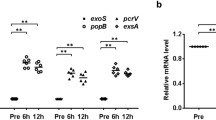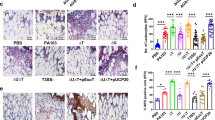Abstract
As the first line of host defense, inflammatory responses in response to bacterial infection are initiated by the production of a range of mediators. Infection of Pseudomonas aeruginosa has been shown to stimulate the production of bradykinin (BK), which is known as a universal mediator for the induction of inflammatory reaction via the predominant interaction with the bradykinin B2 receptor (B2R). Thus, the interaction between BK and B2R represents an important host innate response against invading P. aeruginosa. However, the contribution of P. aeruginosa to the up-regulation of B2R expression remains unclear. Here, we report that P. aeruginosa is potent in inducing the expression of B2R at the mRNA and protein levels in a dose- and time-dependent manner. Components produced and secreted from P. aeruginosa could play an essential role in inducing B2R expression, and the secreted components are not under the control of Type III secretion system or quorum sensing. B2R expression in response to P. aeruginosa is mediated by the induction of cellular signaling that leads to the activation of transcription factor NF-κB. Thus, this study demonstrates that P. aeruginosa is able to up-regulate the expression of B2R during infection via the NF-κB signaling pathway.




Similar content being viewed by others
References
Austin CE, Faussner A, Robinson HE, Chakravarty S, Kyle DJ, Bathon JM, Proud D (1997) Stable expression of the human kinin B1 receptor in Chinese hamster ovary cells. Characterization of ligand binding and effector pathways. J Biol Chem 272:11420–11425
Bachar O, Adner M, Uddman R, Cardell LO (2004) Toll-like receptor stimulation induces airway hyper-responsiveness to bradykinin, an effect mediated by JNK and NF-kappaB signaling pathways. Eur J Immunol 34:1196–1207
Bengtson SH, Phagoo SB, Norrby-Teglund A, Pahlman L, Morgelin M, Zuraw BL, Leeb-Lundberg LM, Herwald H (2006) Kinin receptor expression during Staphylococcus aureus infection. Blood 108:2055–2063
Brint JM, Ohman DE (1995) Synthesis of multiple exoproducts in Pseudomonas aeruginosa is under the control of rhlR-rhlI, another set of regulators in strain pao1 with homology to the autoinducer-responsive luxR-luxI family. J Bacteriol 177:7155–7163
Coin D, Louis D, Bernillon J, Guinand M, Wallach J (1997) LasA, alkaline protease and elastase in clinical strains of Pseudomonas aeruginosa: quantification by immunochemical methods. FEMS Immunol Med Microbiol 18:175–184
Forteza R, Lauredo IT, Burch R, Abraham WM (1994) Extracellular metabolites of Pseudomonas aeruginosa produce bronchoconstriction by different mechanisms. Am J Respir Crit Care Med 149:687–693
Fridlianskaia II, Polianskaia GG, Blomquist G, Tatulian SA, Pinaev GP (1983) Expression of the traits characterizing the cell surface in hybrids of malignant and nonmalignant cells. Tsitologiia 25:593–600
Ha U, Jin S (2001) Growth phase-dependent invasion of Pseudomonas aeruginosa and its survival within hela cells. Infect Immun 69:4398–4406
Ha U, Lim JH, Jono H, Koga T, Srivastava A, Malley R, Pages G, Pouyssegur J, Li JD (2007) A novel role for IkappaB kinase (IKK) alpha and IKKbeta in ERK-dependent up-regulation of MUC5AC mucin transcription by Streptococcus pneumoniae. J Immunol 178:1736–1747
Haddad EB, Fox AJ, Rousell J, Burgess G, McIntyre P, Barnes PJ, Chung KF (2000) Post-transcriptional regulation of bradykinin B1 and B2 receptor gene expression in human lung fibroblasts by tumor necrosis factor-alpha: modulation by dexamethasone. Mol Pharmacol 57:1123–1131
Hall JM (1992) Bradykinin receptors: pharmacological properties and biological roles. Pharmacol Ther 56:131–190
Hall JM (1997) Bradykinin receptors. Gen Pharmacol 28:1–6
Hatada EN, Krappmann D, Scheidereit C (2000) NF-kappaB and the innate immune response. Curr Opin Immunol 12:52–58
Holder IA, Neely AN (1989) Pseudomonas elastase acts as a virulence factor in burned hosts by Hageman factor-dependent activation of the host kinin cascade. Infect Immun 57:3345–3348
Huang TJ, Haddad EB, Fox AJ, Salmon M, Jones C, Burgess G, Chung KF (1999) Contribution of bradykinin B1 and B2 receptors in allergen-induced bronchial hyperresponsiveness. Am J Respir Crit Care Med 160:1717–1723
Kaman WE, Wolterink AF, Bader M, Boele LC, van der Kleij D (2009) The bradykinin B2 receptor in the early immune response against listeria infection. Med Microbiol Immunol 198:39–46
Kaufman MR, Jia J, Zeng L, Ha U, Chow M, Jin S (2000) Pseudomonas aeruginosa mediated apoptosis requires the ADP-ribosylating activity of ExoS. Microbiology 146:2531–2541
Khan MM, Yamamoto T, Araki H, Shibuya Y, Kambara T (1993) Role of Hageman factor/kallikrein-kinin system in pseudomonal elastase-induced shock model. Biochim Biophys Acta 1157:119–126
Machen TE (2006) Innate immune response in CF airway epithelia: hyperinflammatory? Am J Physiol Cell Physiol 291:C218–C230
Mattsson E, Herwald H, Cramer H, Persson K, Sjobring U, Bjorck L (2001) Staphylococcus aureus induces release of bradykinin in human plasma. Infect Immun 69:3877–3882
Molla A, Yamamoto T, Akaike T, Miyoshi S, Maeda H (1989) Activation of Hageman factor and prekallikrein and generation of kinin by various microbial proteinases. J Biol Chem 264:10589–10594
Pearson JP, Pesci EC, Iglewski BH (1997) Roles of Pseudomonas aeruginosa las and rhl quorum-sensing systems in control of elastase and rhamnolipid biosynthesis genes. J Bacteriol 179:5756–5767
Prado GN, Taylor L, Zhou X, Ricupero D, Mierke DF, Polgar P (2002) Mechanisms regulating the expression, self-maintenance, and signaling-function of the bradykinin B2 and B1 receptors. J Cell Physiol 193:275–286
Rahme LG, Stevens EJ, Wolfort SF, Shao J, Tompkins RG, Ausubel FM (1995) Common virulence factors for bacterial pathogenicity in plants and animals. Science 268:1899–1902
Regoli D, Barabe J (1980) Pharmacology of bradykinin and related kinins. Pharmacol Rev 32:1–46
Rumbaugh KP, Griswold JA, Hamood AN (2000) The role of quorum sensing in the in vivo virulence of Pseudomonas aeruginosa. Microbes Infect 2:1721–1731
Sawa T, Ohara M, Kurahashi K, Twining SS, Frank DW, Doroques DB, Long T, Gropper MA, Wiener-Kronish JP (1998) In vitro cellular toxicity predicts Pseudomonas aeruginosa virulence in lung infections. Infect Immun 66:3242–3249
Stewart JM (1995) Bradykinin antagonists: development and applications. Biopolymers 37:143–155
Tuomanen EI, Austrian R, Masure HR (1995) Pathogenesis of pneumococcal infection. N Engl J Med 332:1280–1284
Whiteley M, Parsek MR, Greenberg EP (2000) Regulation of quorum sensing by RpoS in Pseudomonas aeruginosa. J Bacteriol 182:4356–4360
Wilson R, Pitt T, Taylor G, Watson D, MacDermot J, Sykes D, Roberts D, Cole P (1987) Pyocyanin and 1-hydroxyphenazine produced by Pseudomonas aeruginosa inhibit the beating of human respiratory cilia in vitro. J Clin Invest 79:221–229
Yahr TL, Wolfgang MC (2006) Transcriptional regulation of the Pseudomonas aeruginosa typeIII secretion system. Mol Microbiol 62:631–640
Yayama K, Hiyoshi H, Sugiyama K, Okamoto H (2006) The lipopolysaccharide-induced up-regulation of bradykinin B2-receptor in the mouse heart is mediated by tumor necrosis factor-alpha and angiotensin II. Biol Pharm Bull 29:1143–1147
Zhu H, Thuruthyil SJ, Willcox MD (2002) Determination of quorum-sensing signal molecules and virulence factors of Pseudomonas aeruginosa isolates from contact lens-induced microbial keratitis. J Med Microbiol 51:1063–1070
Acknowledgments
This research was supported by the Converging Research Center Program through the National Research Foundation of Korea (NRF) funded by the Ministry of Education, Science and Technology (no. 20090083290).
Author information
Authors and Affiliations
Corresponding author
Rights and permissions
About this article
Cite this article
Shin, HS., Ha, UH. Up-Regulation of Bradykinin B2 Receptor by Pseudomonas aeruginosa via the NF-κB Pathway. Curr Microbiol 63, 138–144 (2011). https://doi.org/10.1007/s00284-011-9959-4
Received:
Accepted:
Published:
Issue Date:
DOI: https://doi.org/10.1007/s00284-011-9959-4




